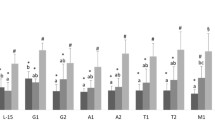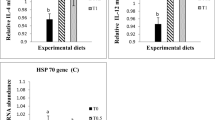Abstract
The future for a sustainable aquaculture relies on the formulation of feed including alternatives to fish meal and fish oil that do not impair fish growth and that improve fish health status. Grain legumes such as field peas and chickpeas offer good sources of proteins, carbohydrates, fibers, vitamins, and minerals. The effect of peas and chickpeas on the immune system of seabream was assessed in vitro in order to detect any potential immunosuppressing problem. Peas was determined to be a better fishmeal alternative than chickpeas as they induced higher respiratory burst measured by the nitro blue tetrazolium assay and primed the Phorbol 12-myristate 13-acetate (PMA)-stimulated intracellular respiratory burst whereas chickpeas neither directly stimulated respiratory burst nor primed it. However, when the intra- and extracellular respiratory burst activities were taken into account, high concentrations of peas inhibited the zymosan- and PMA-triggered chemiluminescence. This apparent reduction of the production of reactive oxygen species may reflect in fact the antioxidant activity of legumes. This, together with the absence of effect on the phagocytosis activity, suggested that peas are not immunosuppressing gilthead seabream. Further in vivo studies preferably comporting a bacterial challenge will have to ascertain the absence of immunosuppressing effect of these legumes.




Similar content being viewed by others
References
Adamidou S.; Nengas I.; Henry M. et al. Effects of dietary inclusion of peas, chickpeas and faba beans on growth, feed utilization and health of gilthead seabream (Sparus aurata). Aquac. Nutr. 17: e288–e296; 2011.
Ardó L.; Yin G.; Xu P. et al. Chinese herbs (Astragalus membranaceus and Lonicera japonica) and boron enhance the non-specific immune response of Nile tilapia (Oreochromis niloticus) and resistance against Aeromonas hydrophila. Aquaculture 275: 26–33; 2008.
Aruoma O. I.; Halliwell B.; Dizdaroglu M. Iron ion-dependent modification of bases in DNA by the superoxide radical-generating system hypoxanthine/xanthine oxidase. J. Biol. Chem. 264: 13024–13028; 1989.
Daels-Rakotoarison D. A.; Gressier B.; Trotin F. et al. Effects of Rosa canina fruit extract on neutrophil respiratory burst. Phytother. Res. 16: 157–161; 2002.
Dalmo R. A.; Seljelid R. The immunomodulatory effect of LPS, laminaran and sulphated laminaran [β (1,3)-d-glucan] on Atlantic salmon, Salmo salar L., macrophages in vitro. J. Fish Dis. 18: 175–185; 1995.
Drakeford B.; Pascoe S. Substitutability of fishmeal and fish oil in diets for salmon and trout: a meta-analysis. Aquac. Econ. Manag. 12: 155–175; 2008.
Dügenci S. K.; Arda N.; Candan A. Some medicinal plants as immunostimulant for fish. J. Ethnopharmacol. 88: 99–106; 2003.
El-Sayed A.-F. M.; Tacon A. G. J. Fishmeal replacers for tilapia: a review. Cah. Options Mediterraneennes 22: 205–224; 1997.
Engstad R. E.; Robertson B. Effect of structurally different yeast β-glucans on immune responses in Atlantic salmon (Salmo salar L.). J. Mar. Biotechnol. 3: 203–207; 1995.
Gabriel I.; Lessire M.; Juin H. et al. Variation in seed protein digestion of different pea (Pisum sativum L.) genotypes by cecectomized broiler chickens: 1. Endogenous amino acid losses, true digestibility and in vitro hydrolysis of proteins. Livest. Sci. 113: 251–261; 2008.
Hardy R. W. Utilization of plant proteins in fish diets: effects of global demand and supplies of fishmeal. Aquac. Res. 41: 770–776; 2010.
Harikrishnan R.; Balasundaram C.; Dharaneedharan S. et al. Effect of plant active compounds on immune response and disease resistance in Cirrhina mrigala infected with fungal fish pathogen, Aphanomyces invadans. Aquac. Res. 40: 1170–1181; 2009a.
Harikrishnan R.; Balasundaram C.; Kim M. C. et al. Innate immune response and disease resistance in Carassius auratus by triherbal solvent extracts. Fish Shellfish Immunol. 27: 508–515; 2009b.
Henry M. A.; Alexis M. N. Effects of in vitro lactoferricin and lactoferrin on the head kidney cells of European sea bass (Dicentrarchus labrax, L.). Vet. Immunol. Immunopathol. 130: 236–242; 2009.
Henry M. A.; Alexis M. N.; Fountoulaki E. et al. Effects of a natural parasitical infection (Lernanthropus kroyeri) on the immune system of European sea bass, Dicentrarchus labrax L. Parasite Immunol. 31: 729–740; 2009.
Jang S. I.; Marsden M. J.; Kim Y. G. et al. The effect of glycyrrhizin on rainbow trout, Oncorhynchus mykiss (Walbaun), leucocyte responses. J. Fish Dis. 18: 307–315; 1995.
Jezierny D.; Mosenthin R.; Bauer E. The use of grain legumes as a protein source in pig nutrition: a review. Anim. Feed Sci. Technol. 157: 111–128; 2010.
Jian J.; Wu Z. Effects of traditional Chinese medicine on nonspecific immunity and disease resistance of large yellow croaker, Pseudosciaena crocea (Richardson). Aquaculture 218: 1–9; 2003.
Jian J.; Wu Z. Influences of traditional Chinese medicine on non-specific immunity of Jian Carp (Cyprinus carpio var. Jian). Fish Shellfish Immunol. 16: 185–191; 2004.
Jørgensen J. B.; Robertsen B. Yeast [beta]-glucan stimulates respiratory burst activity of Atlantic salmon (Salmo salar L.) macrophages. Dev. Comp. Immunol. 19: 43–57; 1995.
Kim K. J.; Jang S. I.; Marsden M. J. et al. Effect of glycyrrhizin on rainbow trout Oncorhynchus mykiss leukocyte responses. J. Korean Soc. Microbiol. 33: 263–271; 1998.
Kim K. H.; Hwang Y. J.; Bai S. C. Resistance to Vibrio alginolyticus in juvenile rockfish (Sebastes schlegeli) fed diets containing different doses of aloe. Aquaculture 180: 13–21; 1999.
Kim Y.-H.; Kim Y.; Cho E. et al. Alterations in intracellular and extracellular activities of antioxidant enzymes during suspension culture of sweetpotato. Phytochemistry 65: 2471–2476; 2004.
Kudrenko B.; Snape N.; Barnes A. C. Linear and branched β(1–3) d-glucans activate but do not prime teleost macrophages in vitro and are inactivated by dilute acid: Implications for dietary immunostimulation. Fish Shellfish Immunol. 26: 443–450; 2009.
Lima J. E.; Sampaio A. L. F.; Henriques M. G. M. O. et al. Lymphocyte activation and cytokine production by Pisum sativum agglutinin (PSA) in vivo and in vitro. Immunopharmacology 41: 147–155; 1999.
Logambal S. M.; Michael R. D. Immunostimulatory effect of Azadirachtin in Oreochromis mossambicus (Peters). Indian J. Exp. Biol. 38: 1092–1096; 2000.
Logambal S. M.; Michael R. D. Azadirachtin—an immunostimulant for Oreochromis mossambicus (Peters). J. Aquacult. Trop. 16: 339–347; 2001.
Miller M. R.; Nichols P. D.; Carter C. G. N-3 Oil sources for use in aquaculture alternatives to the unsustainable harvest of wild fish. Nutr. Res. Rev. 21: 85–96; 2008.
Moncada S.; Palmer R. M. J.; Higgs E. A. Nitric oxide: physiology, pathophysiology and pharmacology. Pharmacol. Rev. 43: 109–142; 1991.
Naylor R. L.; Hardy R. W.; Bureau D. P. et al. Feeding aquaculture in an era of finite resources. Proc. Natl. Acad. Sci. U. S. A. 106: 15103–15110; 2009.
Nikolopoulou D.; Grigorakis K.; Stasini M. et al. Differences in chemical composition of field pea (Pisum sativum) cultivars: effects of cultivation area and year. Food Chem. 103: 847–852; 2007.
Nikoskelainen S.; Verho S.; Airas K. et al. Adhesion and ingestion activities of fish phagocytes induced by bacterium Aeromonas salmonicida can be distinguished and directly measured from highly diluted whole blood of fish. Dev. Comp. Immunol. 29: 525–537; 2005.
Ninomiya M.; Hatta H.; Fujiki M. et al. Enhancement of chemotactic activity of yellowtail (Seriola quinqueradiata) leucocytes by oral administration of Quillaja saponin. Fish Shellfish Immunol. 5: 325–327; 1995.
Pereira T. G.; Oliva-Teles A. Preliminary evaluation of pea seed meal in diets for gilthead seabream (Sparus aurata) juveniles. Aquac. Res. 33: 1183–1189; 2002.
Prusty A. K.; Sahu N. P.; Pal A. K. et al. Effect of dietary tannin on growth and haemato-immunological parameters of Labeo rohita (Hamilton) fingerlings. Anim. Feed Sci. Technol. 136: 96–108; 2007.
Racine R. A.; Deckelbaum R. J. Sources of the very-long-chain unsaturated omega-3 fatty acids: eicosapentaenoic acid and docosahexaenoic acid. Curr. Opin. Clin. Nutr. Metab. Care 10: 123–128; 2007.
Rook G. A. W.; Steele J.; Umar S. et al. A simple method for the solubilisation of reduced NBT, and its use as a colorimetric assay for activation of human macrophages by γ-interferon. J. Immunol. Methods 82: 161–167; 1985.
Roy F.; Boye J. I.; Simpson B. K. Bioactive proteins and peptides in pulse crops: pea, chickpea and lentil. Food Res. Int. 43: 432–442; 2010.
Siwicki A. K. Immunostimulating influence of levamisole on non-specific immunity in carp (C. carpio). Dev. Comp. Immunol. 13: 87–91; 1989.
Siwicki A. K.; Anderson D. P.; Rumsey G. L. Dietary intake of immunostimulants by rainbow trout affects non-specific immunity and protection against furunculosis. Vet. Immunol. Immunopathol. 41: 125–139; 1994.
Stone D. A. J. Dietary carbohydrate utilization by fish. Rev. Fish. Sci. 11: 337–369; 2003.
Tacon A. G. J. Feed ingredients for carnivorous fish species: alternatives to fishmeal and other fishery resources. FAO Fish. Circ. 881: 39; 1994.
Van Barneveld S. L. Chemical and physical characteristics of grains related to variability in energy and amino acid availability in ruminants: a review. Aust. J. Agric. Res. 50: 651–666; 1999.
Vasconcelos I. M.; Oliveira J. T. A. Antinutritional properties of plant lectins. Toxicon 44: 385–403; 2004.
Vasta G. R.; Nita-Lazar M.; Giomarelli B. et al. Structural and functional diversity of the lectin repertoire in teleost fish: relevance to innate and adaptive immunity. Dev. Comp. Immunol. 35: 1388–1399; 2011.
Vidal-Valverde C.; Frias J.; Hernandez A. et al. Assessment of nutritional compounds and antinutritional factors in pea (Pisum sativum) seeds. J. Sci. Food Agric. 83: 298–306; 2003.
Wang N.; Daun J. K. Effect of variety and crude protein content on nutrients and certain antinutrients in field peas (Pisum sativum). J. Sci. Food Agric. 84: 1021–1029; 2004.
Watanuki H.; Gushiken Y.; Takahashi A. et al. In vitro modulation of fish phagocytic cells by β-endorphin. Fish Shellfish Immunol. 10: 203–212; 2000.
Yin G.; Ardo L.; Thompson K. D. et al. Chinese herbs (Astragalus radix and Ganoderma lucidum) enhance immune response of carp, Cyprinus carpio, and protection against Aeromonas hydrophila. Fish Shellfish Immunol. 26: 140–145; 2009.
Yin G.; Wiegertjes G.; Li Y. et al. Effect of Astragalus radix on proliferation and nitric oxide production of head kidney macrophages in Cyprinus carpio: an in vitro study. J. Fish. China 28: 628–632; 2004.
Yuan C.; Li D.; Chen W. et al. Administration of a herbal immunoregulation mixture enhances some immune parameters in carp (Cyprinus carpio). Fish Physiol. Biochem. 33: 93–101; 2007.
Author information
Authors and Affiliations
Corresponding author
Additional information
Editor: T. Okamoto
Rights and permissions
About this article
Cite this article
Henry, M.A., Nikolopoulou, D. & Alexis, M.N. In vitro effect of peas, Pisum pisum, and chickpeas, Cicer arietinum, on the immune system of gilthead seabream, Sparus aurata . In Vitro Cell.Dev.Biol.-Animal 48, 407–412 (2012). https://doi.org/10.1007/s11626-012-9528-6
Received:
Accepted:
Published:
Issue Date:
DOI: https://doi.org/10.1007/s11626-012-9528-6




